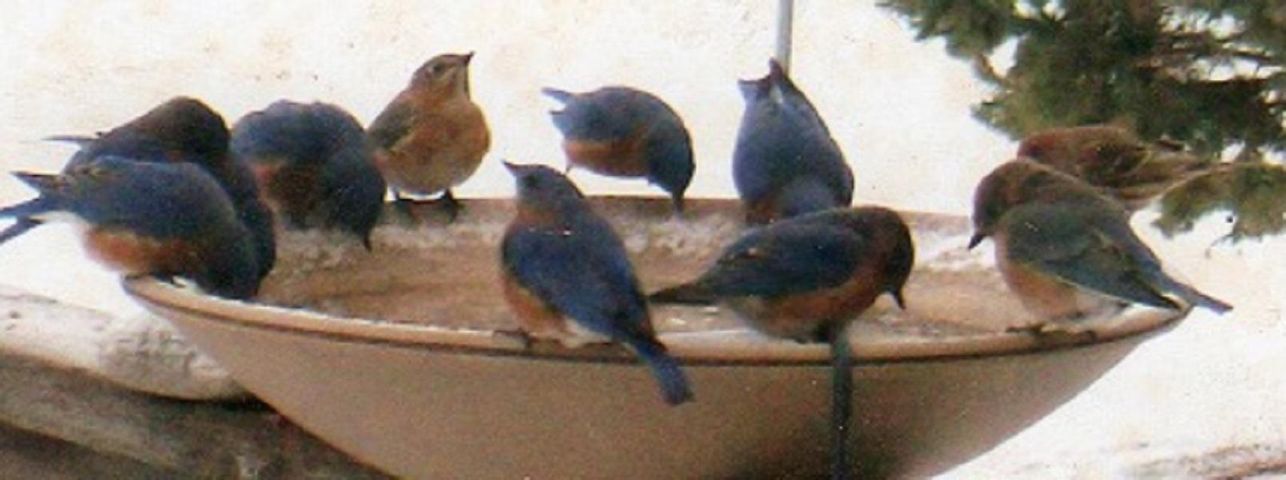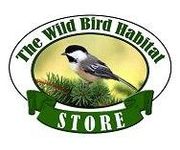
Winter is approaching and, as temperatures plunge below  freezing, birds will have difficulty locating a source of open water. Providing a source of fresh water for backyard birds during the winter months can be a beneficial addition to your winter bird feeding program, often attracting more birds than just the wild bird feed in your feeders.
freezing, birds will have difficulty locating a source of open water. Providing a source of fresh water for backyard birds during the winter months can be a beneficial addition to your winter bird feeding program, often attracting more birds than just the wild bird feed in your feeders.
During the winter most birds are a mere 36 hours from starvation. So the calories from the food they consume becomes an essential source of energy to keep warm. That energy is easily depleted in flight when searching for an open source of water. Eating snow is an alternative for birds to stay hydrated, but it reduces their body temperature requiring additional food to restore their energy levels. And just as important as staying hydrated is bathing to keep clean. Clean feathers help to conserve energy during cold winter nights by providing better insulation which aides a bird in maintaining a maximum body temperature to keep warm.
A source of water for the birds in your backyard may be as simple as pouring water in a bird bath or dish once or twice a day at approximately the same time. Birds will become accustomed to when that water is available and show up. However an easier method to provide water in winter for birds is to add a bird bath heater or de-icer to your current bird bath or in a dish. There are also bird baths available with a built in heating element. Several are designed for year round use where you simply plug in these bird baths during the winter months.
BIRD BATH DE-ICERS AND HEATED BIRD BATHS
Heated bird baths and de-icers come with a one to four year  warranty and operate on standard household current. These devices are thermostatically controlled and range from 60 watts to 500 watts. They are low voltage and consume very little energy to operate, about as much as a 60 watt lightbulb. You can use de-icers in plastic, polypropylene, metal, and concrete bird baths.
warranty and operate on standard household current. These devices are thermostatically controlled and range from 60 watts to 500 watts. They are low voltage and consume very little energy to operate, about as much as a 60 watt lightbulb. You can use de-icers in plastic, polypropylene, metal, and concrete bird baths.
Heated bird baths provide a larger open water surface area in temperatures of 20 degrees and below where as de-Icers in a standard bird bath provide an ample open water area at temperatures of 20 degrees and below. Both are adequate in providing birds with fresh water for drinking to maintain hydration. This will also provide adequate water for bathing although most birds rarely bathe when the temperature drops below 25 degrees
temperatures of 20 degrees and below where as de-Icers in a standard bird bath provide an ample open water area at temperatures of 20 degrees and below. Both are adequate in providing birds with fresh water for drinking to maintain hydration. This will also provide adequate water for bathing although most birds rarely bathe when the temperature drops below 25 degrees
Bird Bath De-icers available at the Wild Bird Habitat Stores
Heated Bird Baths available at the Wild Bird Habitat Stores
We have just had our first taste of temperatures near freezing on the Great Plains. In some areas folks may have woke-up to a thin layer of ice on their bird baths. The weather is going to warm up again as this is just a reminder of what is to come.
HOW TO TEST A BIRD BATH HEATER OR DE-ICER
Now is a great time to check that bird bath de-icer you may have already to make certain it is functioning properly. After-all, it is easier to address this matter when the temperatures are in the sixties than when they fall to below freezing.
Here is a simple method to test your bird bath de-icer. Unplug  the de-icer and place it in your freezer for 30 minutes. This is necessary as the thermostat will not function until the de-icer is in an environment below 32 degrees. Remove the de-icer and immediately plug it in. Give it a minute or two and feel if the de-icer is beginning to warm up. They are designed to either work or not. If it feels warm you are good to go.
the de-icer and place it in your freezer for 30 minutes. This is necessary as the thermostat will not function until the de-icer is in an environment below 32 degrees. Remove the de-icer and immediately plug it in. Give it a minute or two and feel if the de-icer is beginning to warm up. They are designed to either work or not. If it feels warm you are good to go.
If the de-icer does not feel warm after the freezer test check the following:
Is the de-icer covered with a coating of deposits from last year? Try placing the de-icer in a solution of vinegar and water to soak. Then using a stiff brush scrub the deposits off and re-test the de-icer using the freezer method.
If the de-icer still fails to warm up check to make certain the outlet you are plugging it into is functioning. If you are testing the de-icer using an extension cord make certain the extension cord is working properly. Avoid extension cords over 25 feet as the resistance in a long cord may not allow enough energy for the de-icer to work properly.
If after cleaning and making sure the power source is working properly and the de-icer still does not begin to warm up after the freezer test it may be time to replace the bird bath de-icer.
Bird Bath De-Icers at Wild Bird Habitat Stores
Water In Winter - Its For The Birds
MAINTAINING A CLEAN BIRD BATH
The easiest way to clean a birdbath is to ensure it doesn’t get dirty. While all birdbaths will eventually need to be cleaned, there are steps that can be taken to minimize the need for frequent cleanings.
- When refilling the birdbath, dump out the stagnant water instead of just adding more.
- Position the birdbath away from feeders so spilled seed will not land in the water.
- Choose a shady spot for the birdbath to minimize algae growth and slow evaporation. Sunlight promotes algae growth.
- Position the birdbath where it will not be clogged by grass clippings, falling leaves and other debris.
No matter how carefully a birdbath is maintained it will still need periodic cleanings.
Materials needed…
- Water
- Scrub brush – appropriate for birdbath construction
- Rubber gloves
- Chlorine bleach or vinegar
- Note: Always wear rubber gloves when cleaning a birdbath to avoid contamination from fecal matter in the water or on the surface of the birdbath.
- Dump out any old, stagnant water.
- Remove any large deposits of spilled seed, feces, debris or other contaminants.
- Use a solution of one part chlorine bleach to nine parts water to scrub the birdbath thoroughly. (NOTE: on bird baths with a decorative stain finish test the solution on a small spot first to make sure the solution does not discolor the finish. A weak solution of vingar may be a better choice on stain finished bird baths, or use a commercial bird bath cleaner available at Wild Bird Habitat
- Scrub the basin, lip, and any area of the birdbath where the birds can land, perch, drink or bathe. For extremely dirty birdbaths, it may be necessary to allow the bleach solution to soak for several minutes, but monitor or cover the bath during that time to be sure no birds drink.
- Rinse the birdbath thoroughly with running water until there is no persistent foaming.
- Allow the birdbath to dry completely. This is a good opportunity to clean the area around the bird
- Refill the bath with fresh, clean water.
TIPS FOR CLEANING A BIRDBATH
A clean, filled birdbath can be an oasis for many species of birds. For the best results when cleaning the birdbath:
- Thoroughly clean the birdbath every week or two depending on how many birds are using it.
- Use a jet of water to rinse out the birdbath between regular cleanings.
- Clean the entire birdbath fixture at regular intervals.
- Consider adding enzymes approved for wildlife consumption (available at Wild Bird Habitat) to help keep the bath clean and minimize algae growth.
- Keep the birdbath full to avoid concentrating pollutants in smaller amounts of water.
- Consider adding a dripper to keep the bath replenished with fresh water during times of high usage and evaporation.
BIRDBATH PROTECTOR
Our Birdbath Protector is formulated for outdoor birdbaths that contain approximately two gallons of water or less. Birdbath Protector is an 8 oz. bottle. The cap on the bottle will treat 1/2 to 2 gallons of water. Prevents stains, organic contaminants, and mineral deposits. Keeps water clean and clear naturally. Safe for wildlife and pets that may drink from birdbath. Non-toxic.
If you have more questions about bird feeding and want to give your local birds appropriate winter food, turn to the experts at Wild Bird Habitat Store in Lincoln, NE. This family-owned and -operated backyard bird feeding store offers a variety of bird feeders and backyard bird feeding supplies, along with 21 varieties of premium NON-GMO, pesticide free wild bird feeds to attract all sorts of birds to your yard. To learn more about birds and how to feed them, call (402) 420-2553 today, Toll Free at (800)-606-2553 or visit Wild Bird Habitat’s online learning center.
About the Business
Have a question? Ask the experts!
Send your question

